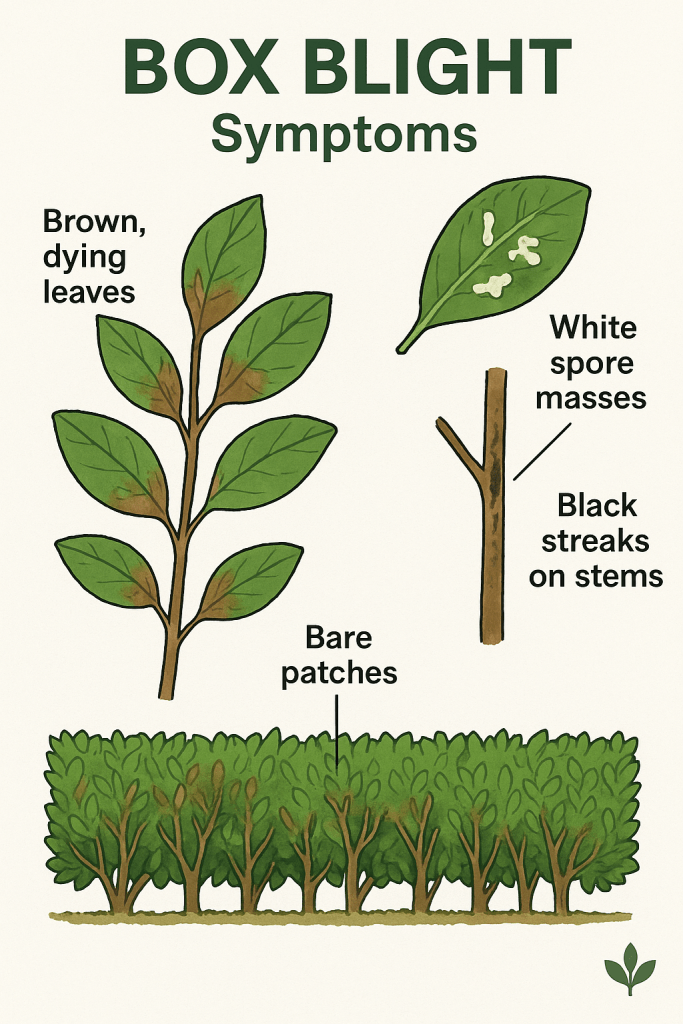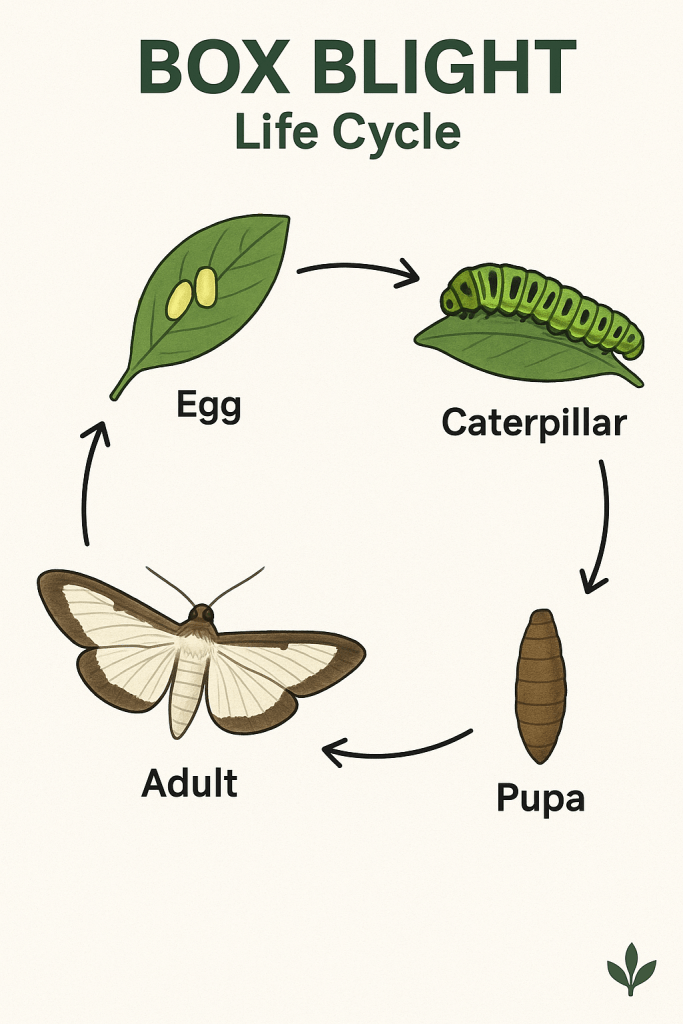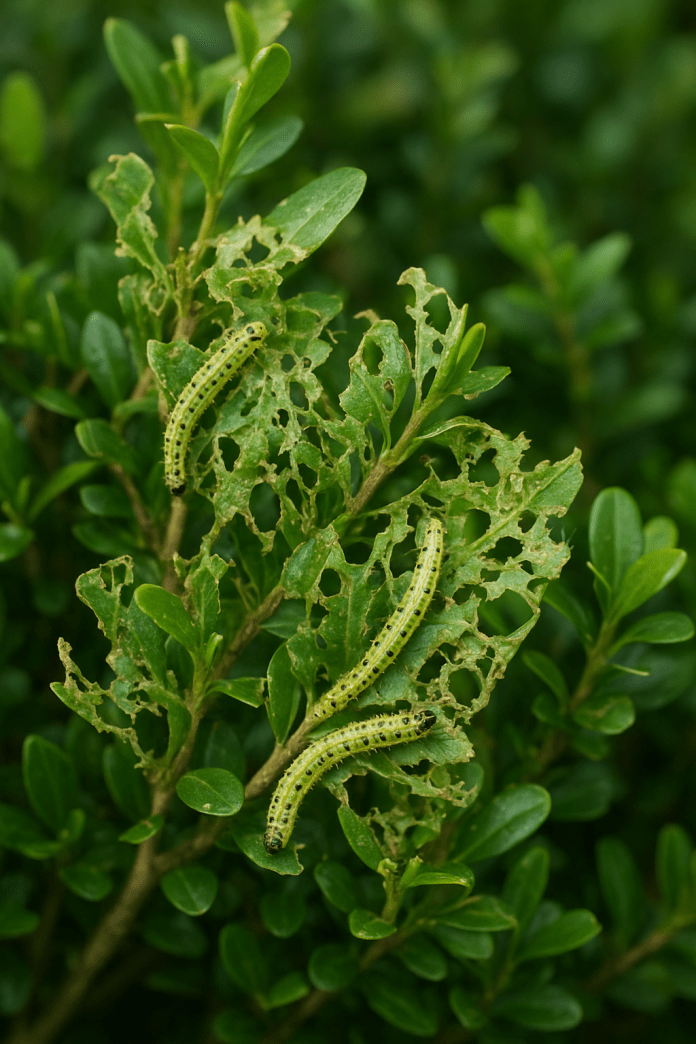How to diagnose, prevent and treat Box Blight and Box Tree Caterpillar in accordance with UK law
Box hedges (Buxus sempervirens and related species) have long been a staple of British gardens — framing parterres, edging borders, and forming centuries-old topiary. Yet over the past two decades, two major threats have tested the patience of even the most skilled gardener: Box Blight and Box Tree Caterpillar. Managing these issues effectively now requires not just horticultural knowledge but also an understanding of the UK’s pesticide regulations.
This guide explains how to diagnose both problems and outlines legal treatment options for professional and home gardeners.
1. Diagnosing Box Blight
The disease
Box Blight is a fungal infection caused primarily by Calonectria pseudonaviculata (previously Cylindrocladium buxicola). It thrives in humid, poorly ventilated conditions and spreads rapidly through contaminated tools, clothing, or infected plant material.
Symptoms
- Dark brown or black leaf spots that often merge.
- Rapid defoliation – leaves fall within days, leaving bare twigs.
- Black streaks on stems, especially near the base.
- White fungal spore masses visible on the undersides of infected leaves during humid weather.
These signs distinguish it from Volutella blight, which causes salmon-pink spore masses.

2. Diagnosing Box Tree Caterpillar
The pest
The Box Tree Caterpillar (Cydalima perspectalis) is the larval stage of a moth native to East Asia. It was first reported in the UK in 2011 and has since spread across most regions.
Symptoms
- Skeletonised leaves – the green tissue is eaten away, leaving a lace-like appearance.
- Silken webbing on shoots and between leaves, often containing frass (droppings).
- Greenish-yellow caterpillars with black heads and stripes up to 4 cm long.
- Severe defoliation, sometimes killing small plants within a single season.
Adult moths are white with a brown border and are often seen around outdoor lights in summer.

3. Cultural and Non-Chemical Control
Before reaching for any chemical product, integrated management should be the first line of defence:
- Improve airflow: open up dense hedges and reduce irrigation splash.
- Sanitation: remove and burn or dispose of infected leaves — never compost them.
- Avoid clipping in wet weather, which spreads spores.
- Monitor regularly: inspect plants in spring and early summer for webbing or caterpillars.
- Encourage natural predators such as birds and parasitic wasps.
- Use resistant alternatives, such as Buxus microphylla ‘Faulkner’ or substitute species like Ilex crenata (Japanese holly).
4. Legal Fungicide Options for Box Blight
The Health and Safety Executive (HSE) regulates all Plant Protection Products (PPPs) in the UK. Each product is authorised for specific plants, pests, and uses under a unique MAPP number. Using an unauthorised product or applying it “off-label” is illegal.
Professional product example
Signum (MAPP 11450) – containing boscalid and pyraclostrobin.
- Status: Professional use only (not for amateur/home use).
- Use: Authorised for amenity and ornamental plant production, including control of Calonectria pseudonaviculata (Box Blight).
- Application: Apply according to label directions; ensure good coverage and adhere to maximum application limits.
Other professional fungicides containing pyraclostrobin or boscalid may also carry similar authorisations. Always read the label and ensure that “Buxus” or “ornamental plants” are specified.
For amateur gardeners
At present, there are no home-garden fungicides explicitly labelled for Box Blight. The RHS advises focusing on cultural control, supported by regular pruning and hygiene, as chemical control alone is unlikely to eradicate the disease.
5. Legal Insecticide Options for Box Tree Caterpillar
Biological controls
The most effective and environmentally responsible control for Cydalima perspectalis is Bacillus thuringiensis var. kurstaki (Bt) — a naturally occurring bacterium that targets caterpillars while leaving other insects unharmed.
- Mode of action: Caterpillars ingest the bacteria when feeding on treated leaves, stopping feeding within hours and dying within a few days.
- Timing: Apply when small caterpillars are first seen (typically April–May and August–September).
- Legal status: Check the HSE Pesticides Database for currently authorised Bt products. Some formulations (e.g., Xentari-type mixes) have faced changes in authorisation status — only use those listed as active and approved in the UK.
Chemical insecticides
There are currently no publicly listed amateur products in the HSE Garden Search database that explicitly name Box Tree Caterpillar on the label. Professional users can check the HSE’s Plant Protection Products Database for insecticides authorised for “ornamental plant production” or “amenity vegetation” and confirm Cydalima perspectalis as a target pest.
6. Checking Authorisations
Always confirm the product’s legality before purchase or use.
How to check:
- Visit the official HSE Pesticides Database:
https://www.hse.gov.uk/pesticides - Select ‘Search for a Product’ or ‘Garden Search’.
- Enter the product name or active ingredient.
- Confirm:
- Authorised uses (plant/pest)
- Professional or amateur status
- Expiry date and any conditions of use
- Keep a record of all PPP use — required for professional gardeners under UK regulations.
7. Integrated Legal Management Strategy
| Problem | Recommended Actions | Legally Approved Treatments |
|---|---|---|
| Box Blight | Prune to improve airflow, remove infected debris, disinfect tools, avoid overhead watering | Professional fungicide such as Signum (boscalid + pyraclostrobin) |
| Box Tree Caterpillar | Hand-pick caterpillars, prune heavily infested shoots, encourage predators | Biological insecticide containing Bacillus thuringiensis (Bt) where authorised |
8. Final Advice
- Never use imported or unregistered products sold online. Even if a product is widely used abroad, it must be authorised by the HSE for UK use.
- Keep training up to date if applying professional-use PPPs.
- Combine cultural and biological methods to reduce chemical dependency and maintain biodiversity.
- Monitor box hedges year-round — early action prevents severe damage.
Further resources
- HSE Plant Protection Products Database – www.hse.gov.uk/pesticides
- Royal Horticultural Society: Box Blight – www.rhs.org.uk/disease/box-blight
- RHS: Box Tree Caterpillar – www.rhs.org.uk/pests/box-tree-caterpillar
Conclusion
Box remains an icon of British horticulture, but controlling its two greatest enemies — Box Blight and Box Tree Caterpillar — now demands diligence, knowledge, and legal awareness. By combining careful monitoring, cultural discipline, and the correct use of authorised plant protection products, it’s possible to maintain healthy, green box hedges for years to come.




